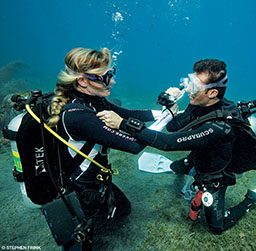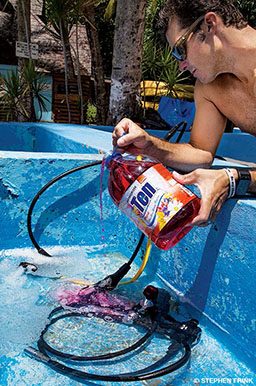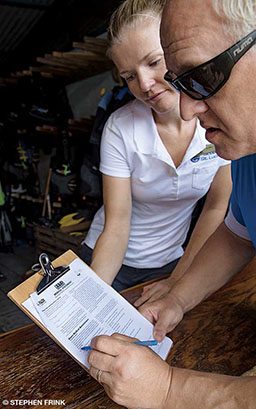The hepatitis C virus (HCV) infection can range from a mild illness to chronic liver disease, cancer or even death. The leading cause of infectious disease deaths in the U.S., HCV has currently infected an estimated 3.5 million Americans. Early symptoms include nausea, malaise, abdominal pain and jaundice, but as many as 70 percent to 80 percent of infected people show no symptoms until the onset of serious liver disease. HCV-related liver disease is now the most common reason for liver transplants in the United States.
HCV is very contagious; a microscopic amount of blood is all that’s required for transmission. While effective vaccines are available for hepatitis A and B, there is not one for HCV. New medications, however, offer promising results: Several drugs, when used over two- to three-month-long treatments, have success rates higher than 90 percent, and in some cases no follow-up is required if there is no additional liver disease.
Divers encounter situations that involve sharing masks, snorkels, helmets and alternate air sources. It is reasonable to be concerned about sharing equipment with a diver who has HCV. A diver’s saliva might be tinged with blood following a barotrauma or abrasion to the lips or gums by a mouthpiece. This diving-specific concern is not directly addressed in the medical literature, but the Centers for Disease Control and Prevention (CDC) states there is a risk of transmission by sharing razors or toothbrushes. Most organizations assume there is no further risk of transmission from people who have undergone treatment, but the Red Cross does not allow blood donation by anyone who has ever tested positive for HCV.
Addressing concerns about hepatitis C can be challenging, and dive supervisors must balance the privacy of the individual with the well-being of the team and the need to make divers aware of any risks to which they may be exposed.
We ask the experts.
Should people with HCV dive? What is the risk of transmission in the context of diving?
Nick Homa, Ph.D.: Assuming there are no acute symptoms that would affect the diver’s safety, there is no medical reason that HCV infection would put a diver at particular risk. The only potential concern is transmission, which would require contact between infected and noninfected blood.

HCV transmission rates are very low in normal circumstances. Transmission requires the infectious virus to reach a person’s blood and then liver to infect hepatocytes, the only cells susceptible to HCV infection. Infected blood coming into contact with intact skin is not sufficient for transmission, but wounds, including invisible microwounds, can provide access to blood. The virus is not generally found outside of the liver or blood, so the risk of transmission via mucus or saliva is low.
Small cuts in the mouth or nose could allow comingling of infected blood with other bodily fluids. If this blood (or blood-tinged fluid) from an HCV-infected diver comes into contact with the blood of another diver, transmission is possible. The two main routes of transmission I can imagine are 1) sharing a mask, in which blood comingled with mucus could come into contact with the mucus of the second diver, and 2) sharing a regulator or snorkel. Both of these routes of transmission would require the virus to overcome several barriers: Viral particles would have to reach the nose, throat or mouth of the infected individual; be transferred via dive equipment (during which they would have to remain stable); and reach the bloodstream of the noninfected diver.
I believe the likelihood of transmission via buddy breathing or air sharing is extremely low, primarily because of the low abundance of virus that would be shed in the mouth. This is assuming neither diver has large or open wounds. Of course, one must not discount the possibility of biting one’s tongue during a dive, for example; that would result in a larger, more productive wound.
Richard Sadler, M.D.: Acute HCV is often not symptomatic and therefore may remain undetected for decades. That is the basis for the CDC’s recommendation that all “baby boomers” (people born between 1945 and 1965) be tested for the virus. Acute symptoms appear one to three months after exposure to the virus and last for two weeks to three months. The presence of symptoms is a contraindication to diving. This is not because diving makes hepatitis worse; rather, the signs might indicate another disease or delay treatment for HCV.
Chronic asymptomatic HCV is treacherous because the infection is not apparent, yet it is still highly contagious. The end-stage symptoms may include bleeding or bruising easily, fatigue, poor appetite, jaundice, dark-colored urine, itchy skin, fluid buildup in the abdomen, swelling in the legs, weight loss, confusion and drowsiness. These are signs of liver failure and are absolute contraindications to diving.
The risk of oral transmission (e.g., via kissing) is quite small and thus not a significant concern. The virus, however, is highly transmissible via the blood — even invisible amounts of blood from toothbrushing, shaving or trimming nails may be enough to spread it. HCV may remain viable for up to three weeks in a moist environment.
While there have been no studies specifically designed to evaluate transmission potential in dive equipment, there are some common-sense general guidelines. First, any shared equipment that is exposed to bodily fluids should be decontaminated after use according to CDC recommendations of rinsing or scrubbing with a 1:10 solution of household bleach and water. (This is sensible advice for any dive team or operation, whether or not there is an HCV carrier.)
Second, the context of the buddy breathing should be considered. Some drills include air sharing with as many as six people as a skill- and confidence-building exercise. But the necessity of this practice is questionable, especially among an unscreened group (e.g., an entry-level dive class with strangers). Consider other ways to teach the desired skills.
Robert Gish, M.D.: Yes, provided they don’t have evidence of cirrhosis by imaging, platelet count or noninvasive scoring systems. If transmission risk in a setting is less than 1 percent, I consider transmission to be extremely rare. I would not consider buddy breathing a significant hazard unless there is clear oral or sinus barotrauma in both divers.
Rahul Sampath, M.D., and Lisa Mangum, FNP: HCV is a single-stranded ribonucleic acid (RNA) virus in the Flaviviridae family. Chronic HCV infection can progress to severe liver disease including cirrhosis and hepatocellular carcinoma. There are no CDC recommendations to restrict people who are infected with HCV from diving, and the risk of transmission from an infected diver to a noninfected diver appears to be low. When a person with HCV decides to dive, the stage of disease should be considered, as should hepatic involvement. Patients with liver disease that has progressed to decompensated cirrhosis may be prone to excessive bleeding. These patients may develop thrombocytopenia (low platelet count) and have decreased carboxylation of vitamin K, resulting in lower levels of coagulation factors. Platelets and coagulation factors are used by the body to form clots and stop bleeding; a decrease in these factors may lead to excessive bleeding. Like all divers, those with HCV should be in good physical condition, and they may wish to receive clearance from a medical provider prior to diving.
Studies have shown that HCV RNA can be detected and quantified in mucosal tissue, salivary glands and saliva, so saliva cannot be ruled out as a possible source of HCV transmission. Sharing of masks or regulators could impart some risk on the buddies of infected divers.

If a diver has HCV, should the buddy, dive team and/or divemaster be made aware? What are the diver’s obligations to other divers?
Homa: My recommendation would be to make the divemaster and the dive buddy aware of the condition. The privacy of the diver with HCV must be considered, but the divemaster has a responsibility to the whole team. While the likelihood of transmission in this context is extremely low, the risk is not zero. Such notification relies on dive staff and the diving public being educated and understanding the risks involved. I do not think the remainder of the dive team needs to be notified.
I might go further to recommend that any divers with HCV and their designated buddies be required to carry independent secondary air sources in case of emergency. If the HCV-infected diver has open wounds in the mouth or nose, I believe he or she should avoid diving, as this considerably increases transmission risks.
Sadler: The legal implications are best considered on a local basis, but ethically speaking, I oppose putting people at elevated risk without their informed consent.
Gish: The risk is extremely low, and a patient’s privacy is important. In my opinion this does not need to be discussed in a public setting, nor does direct notification need to be required. HCV is rarely transmitted other than through direct blood sharing with sharp instruments, sexual contact and, rarely, maternal fetal transmission. No informed consent or specific alerts need to take place; this is a private issue protected by the Health Insurance Portability and Accountability Act of 1996 (HIPAA).
Sampath and Mangum: Yes, the buddy, dive team and divemaster should be made aware. The hepatitis C virus can survive outside the body at room temperature on environmental surfaces for up to three weeks. The buddy and dive team should be made aware of the potential to have exposure to HCV so they can knowingly protect themselves from exposure.
What measures or accommodations are necessary if an HCV-infected person is part of a dive group or dive team?
Homa: Proper education about transmission of any infectious agent is critical for divemasters and instructors. Education is also important for the diving public so potential buddies can make informed decisions about their own well-being. Besides restrictions in the case of open wounds in the mouth or nose, I do not see any other accommodations that would need to be made. It might be reasonable to require divers with a current HCV infection (and/or their buddies) to carry their own secondary air supplies. I would view such a requirement as extreme, but it could improve the peace of mind of other members of the dive team.

Sadler: Accommodations could include separate or isolated equipment, baseline and/or routine screening for the entire team and enforcement of universal precautions (antitransmission protocols such as the use of nitrile gloves implemented by most public safety agencies). Any equipment that is shared by a team, such as a full-face mask, should be decontaminated with a bleach solution.
Diving emergencies are random, potentially deadly and often occur without warning. There is no room to hesitate in taking remedial action. It is imperative that a dive team take whatever steps are necessary to ensure that the presence of HCV in any team member would not cause a second thought or require modification of an action plan.
Considering the elevated risk of public safety dive missions, strong consideration should be given to prioritizing training, and teams should accept the extra burden of screening and meticulous cleaning of shared equipment.
Gish: The most important measure would be to minimize blood exposure from the infected individual to anyone who may have breaks in their skin where some type of direct contact could theoretically take place.
Sampath and Mangum: According to the CDC, HCV is primarily transmitted through large or repeated percutaneous exposure to blood but is also spread infrequently through sharing of personal items such as razors or toothbrushes. Diving carries the risk of exposure to blood and body fluids.
Minimizing the sharing of personal equipment and using pony bottles rather than buddy breathing would be good practices for divers with HCV. As in other settings, first aid for injuries in the diving environment should involve standard precautions (e.g., fluid barriers such as nitrile gloves). Divers with HCV should be particularly cautious about sharing equipment and forthright about disclosing their infection when there are sores or blisters in their mouths, as these could lead to blood exposure if equipment is shared.
Meet the Experts
Robert Gish, M.D., FAASLD, is adjunct professor of medicine at Stanford University.
Nick Homa, Ph.D., studies human pathogens and infectious disease in the Department of Molecular Genetics and Microbiology at Duke University School of Medicine.
Lisa Magnum, FNP, practices internal medicine, travel medicine and infectious disease at Blue Ridge Infectious Disease in Morganton, N.C.
Richard Sadler, M.D., FACS, CHT, is a general, vascular and thoracic surgeon based in Davenport, Iowa; a certified hyperbaric technician; and an avid technical diver. He specializes in undersea and hyperbaric medicine and is the medical director for Dive Rescue International.
Rahul Sampath, M.D., an internal medicine and infectious disease specialist, is the head of Blue Ridge Infectious Disease in Morganton, N.C.
| © Alert Diver — Q4 2017 |